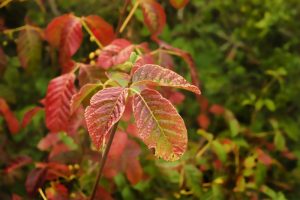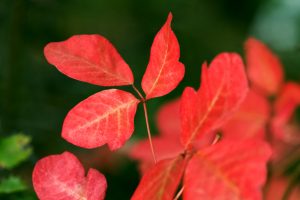Poison Oak: Just as Hazardous as Its More Common Cousin, Poison Ivy
Poison oak has two varieties—one on the East Coast, another in the western states. Both contain the oil that causes a rash and itching.
Poison ivy gets most of the publicity—it’s been called America’s rash—but poison oak is more insidious and just as likely to set off an allergic reaction.
In the western United States, poison oak (also called Western or Pacific oak) can be a ground vine, climbing vine, or shrub that can thrive at sea level and up to 5,000 feet. In the eastern and southeastern states, Atlantic or Eastern poison oak is much less common than poison ivy, but it’s out there waiting for you come into contact with it. Poison oak looks almost identical to poison ivy, and it will give you the same kind of rash.
Where It’s Not
The areas in which the two varieties of poison oak live don’t overlap. You’ll see either Western or Pacific poison on one side of the country; Atlanta or Eastern poison oak on the other. If you live in Hawaii, Alaska, or in desert climates, don’t worry. Poison oak doesn’t exist in those areas, and it rarely exists in the rain forests of Washington state and Oregon.

In late summer, poison oak leaves can take on orange and red hues. (Photo: © Jeffrey Banke | Dreamstime.com)
What Does Poison Oak Look Like?
Poison oak is very good at camouflaging itself to blend in with surrounding plants. Not only can it grow as a low shrub or vine, it can match the colors of other plants. At different times of the year its leaves can be green, white-ish, purple-red, yellow, or orange.
One distinguishing characteristic of poison oak is a slightly fuzzy appearance. Alternating leaves normally consist of three leaflets but can have as many as five, seven, or nine, all of which have somewhat lobed or tooth-like edges. The leaflets range in size from the length of your thumb to the length of your hand. The plants can produce clusters of green/yellow or white berries, and they lose their leaves in winter.

The leaves of the Western poison oak plant may have a more rounded, oval appearance. Eastern poison oak leaves tend to be more jagged (see photo at top of this post).
Western vs Eastern Poison Oak: What’s the Difference?
The difference between Western poison oak and Eastern poison oak is mostly location. However, the Western poison oak leaf has a more rounded, oval appearance. Eastern poison oak leaves have a more pointed look.
What Causes the Allergic Reaction?
Whether its poison oak, poison ivy, or poison sumac, they all contain an oil called urushiol, which is present in the roots, stems, leaves, flowers, and berries. Urushiol causes an allergic reaction in up to 85 percent of people, and it results in a blistering rash and an itch that demands to be scratched.
When a person comes into contact with poison oak, especially a plant that has been bruised or damaged, the urushiol is quickly absorbed into the skin. You’ll begin having symptoms within a few hours or up to six days later. The irritation and itching will be followed by water-filled blisters.
The symptoms seldom last more than 10 days, with or without treatment, and you cannot transmit poison oak symptoms to another person. However, you can have an allergic reaction by coming into contact with clothes, boots, tools, or pets that brushed against poison oak plants.
How Is Poison Oak Treated?
The treatment is the same as it would be for poison ivy. Here are the basics if you come into contact with poison ivy:
- Immediately (within five minutes) rinse your skin with lukewarm, soapy water.
- Wash your clothing, pets, and tools that might have come in contact with poison oak.
- Do not scratch the affected area.
- Consider using calamine lotion or anti-histamine pills to control itching.
- Apply cool compresses.
Get medical help immediately if you experience swelling of the face or throat, a rash in the genital area, swelling or rash that covers a third of your body, rapidly spreading rash, or signs of infection (pain, redness, pus).
How Can I Protect Myself Against Poison Oak?
The best protection from poison ivy is to learn how to recognize the plant—and then stay away from it or remove it.
The California Poison Control System advises you to wear boots, gloves, long pants, and long sleeves when hiking and to stay on trails—away from brush where poison oak plants grow. Take along a hand sanitizer or alcohol prep pads in case you come into contact with the plant and don’t have access to running water.
Take the same precautions when you’re working in a yard or garden where poison oak might have grown. If you remove it, take out the entire plant, roots and all. If you don’t, the plant will reappear the following spring.
Finally, don’t burn poison oak. The oil in the plant can disperse in smoke and cause respiratory irritation to those who inhale it.


 Vestibular Migraine Diet
Vestibular Migraine Diet  Bone Spurs on the Spine
Bone Spurs on the Spine  Knee Injections for Osteoarthritis Pain Relief
Knee Injections for Osteoarthritis Pain Relief 
This photo shows how poison oak can look during springtime growth. Keep in mind, though, that poison oak can have a variety of different looks, as discussed in our post.
© Trekandshoot | Dreamstime.com